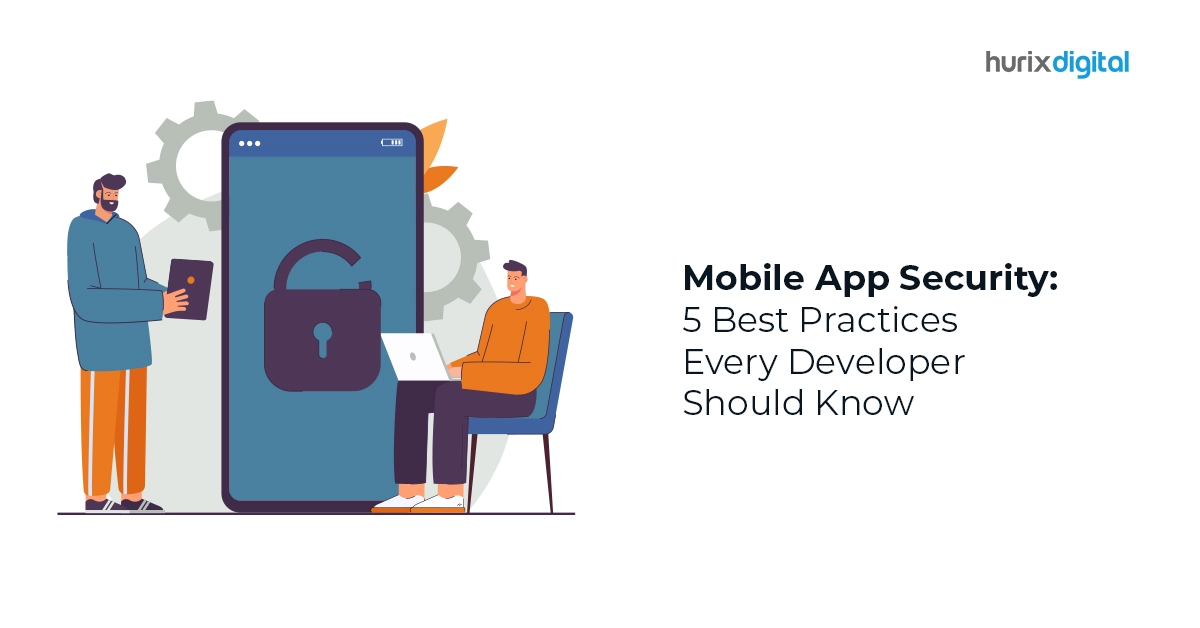
Mobile App Security: 5 Best Practices Every Developer Should Know
The mobile app development landscape is evolving at an unprecedented pace. While this has opened a floodgate of opportunities, there are a plethora of security concerns. For instance, 220 million X (formerly Twitter) users’ email addresses were leaked in 2023.
Now, that’s just the tip of the iceberg! Over the years, several reported and unreported mobile app security breaches have resulted in immense losses. With data becoming the new gold, app security has become more crucial than ever.
If you are a business owner or app developer looking for ways to address app development vulnerabilities and threats, this guide will provide the necessary insights. We will also discuss the best practices for developers to build an app that’s robust and secure.
Let’s get started!
Table of Contents:
- What is Mobile App Security and Its Significance?
- Mobile App Development: Common Security Issues
- Best Practices for Secure Mobile App Development
- Conclusion
What is Mobile App Security and Its Significance?
Mobile app security refers to a set of comprehensive strategies for safeguarding mobile applications and users’ digital identities from various cyber-attacks. It combines technical solutions with the implementation of best practices for app development.
But why is mobile app security so crucial?
As our dependence on mobile apps has increased, the risk of cyberattacks has surged. In fact, a cyberattack occurs every 39 seconds.
A single security breach can result in financial repercussions and lawsuits while adversely impacting the brand’s reputation. That’s why many businesses are taking mobile app security seriously.
This is what happens when your app development process is unsecured:
- Unprotected apps lead to data breaches
- Malicious applications can result in malware attacks
- Vulnerable to unauthorized access to confidential data
- Reputational damage
- Regulatory penalties
- Loss of intellectual property
Also Read: Ready for 2024? The Alt Text Toolkit for Developers and Content Creators
Mobile App Development: Common Security Issues
The incidences of cyberattacks and data breaches continue to rise worldwide. Even as businesses strive to counter these issues, hackers are finding sophisticated ways to exploit loopholes in Android app development.
Knowing the potential threats is the first step to creating a comprehensive and watertight app security plan.
Here are some of the common security hazards that you should consider when building an app:
1. Malicious Malware
Do you know around 17% of all data breaches happen due to malware attacks?
With the rise of e-commerce and banking apps, malware has become a major concern. Once it infiltrates the application, malware can stealthily target sensitive information, resulting in serious data breaches.
2. Phishing Attacks
From fake messages to impersonating a user by hacking into their account, phishing scams have become increasingly sophisticated. Scammers are now employing advanced AI and machine learning to mimic fake messages or calls, making it difficult to figure out malicious requests.
Fake mobile banking apps are a primary example of phishing. These mobile apps often imitate the appearance and functionality of a legitimate app.
3. Insecure Authentication
Lack of robust authentication can pose a serious problem as it allows hackers to decode any type of complex password easily. In other words, insecure authentication provides a red carpet for fraudsters and cybercriminals to infiltrate the application. They can easily access sensitive user data, which makes them susceptible to serious crime.
Secure app development is an ongoing process that requires a proactive approach. By identifying possible dangers, you can implement measures to safeguard their assets and users.
Let’s see some of the best practices that mobile app developers should consider.
Best Practices for Secure Mobile App Development
As mobile apps become an integral life of our lives, ensuring their security has become paramount. Read on as we delve into proactive measures developers can take for secure Flutter app development.
1. Follow Airtight Coding Practices
Coding is the cornerstone of any mobile app development. Hence, its security becomes a top priority.
Secure coding protects the app’s core and makes it immune to cyberattacks such as cross-scripting, Man-in-the-Middle (MiTM), and Distributed Denial of Services (DDoS).
Consider the following points to safeguard your app development from cyberattacks:
- Protects your app against XSS and SQL injection by authenticating every user input.
- Grant limited access to the app’s functionality to bottleneck the possibilities of exposing system vulnerabilities.
- Scrutinize the codes to check for loopholes or discrepancies. Use both static and dynamic analysis for better results.
2. Enforce a Strong Authentication Process
User access points such as biometric authentication or screen locks are common entry points for cyberattacks.
So, what’s the best way to keep malicious elements at bay?
Follow a robust authentication process. This provides an extra layer of protection by ensuring only legitimate users can access the application.
While there are different authentication methods for secure app development, here are three main types:
- Multi-factor authentication (MFA): Ensure robust security by requiring users to offer multiple steps of verification.
- Token-based authentication: This authentication process streamlines user access without uncovering user credentials.
- Session-based authentication: Automatic timeouts safeguard user sessions. For example, bank apps can use this method to keep critical data safe.
3. Robust Data Encryption
In the 21st Century, data is the new gold! And compromising its safety is non-negotiable. Robust data encryption ensures that confidential user information remains safe from hostile elements.
Here are a few points you should take into account while building an app:
- Make sure you encrypt critical data, whether it’s stored or transmitted via the internet.
- Always store encryption keys securely, and if required, rotate them regularly.
- Use reliable storage methods such as secure cloud databases.
4. Regular Monitoring and Testing
The mobile app development landscape is evolving, and so are the dangers. Real-time monitoring and frequent app testing will keep the apps updated against the latest security hazards.
Here’s how you can test and update the mobile apps:
- Simulated cyberattacks will help you recognize loopholes before scammers can exploit them.
- Perform real-time monitoring to stay informed about any possible suspicious activities that may become a serious threat.
- Harness advanced technologies to scan inconsistencies and test the app for any hidden vulnerabilities.
5. Audit and Update Third-Party Libraries and SDKs
Unreliable and unprotected third-party components can lead to security vulnerabilities. So, what is the best way to ensure the safety of third-party libraries and SDKs?
Simple! When building an app, make sure you regularly audit the apps using reliable sources to see whether there are any weak links.
Also Read: How to Boost Your Android App Performance in 2024: A Guide for Developers
Conclusion
The world of app development is complex. With ever-evolving technologies, keeping cybercriminals at bay is a real challenge.
Thankfully, proactive measures, constant learning, and adapting to advanced tools can help you stay ahead of potential cyber threats.
At Hurix Digital, we understand that following best practices for mobile app security can be an uphill task. We are one of the leading companies with years of experience in Android app development, enterprise mobile app development, and Flutter app development.
Our team possesses the right experience and expertise in mobile app development and will guide you through the complicated world of mobile app security.
Want to learn more? Schedule a call and our experts will provide feasible solutions.

Currently serving as the Vice President of Technology Delivery Operations at HurixDigital, a prominent global provider of digital content and technology solutions for publishers, corporations, and educational institutions. With over 16 years of experience spanning EdTech and various domains, I hold certification as a SCRUM Product Owner (CSPO). My expertise includes operations, finance, and adept people management skills.











